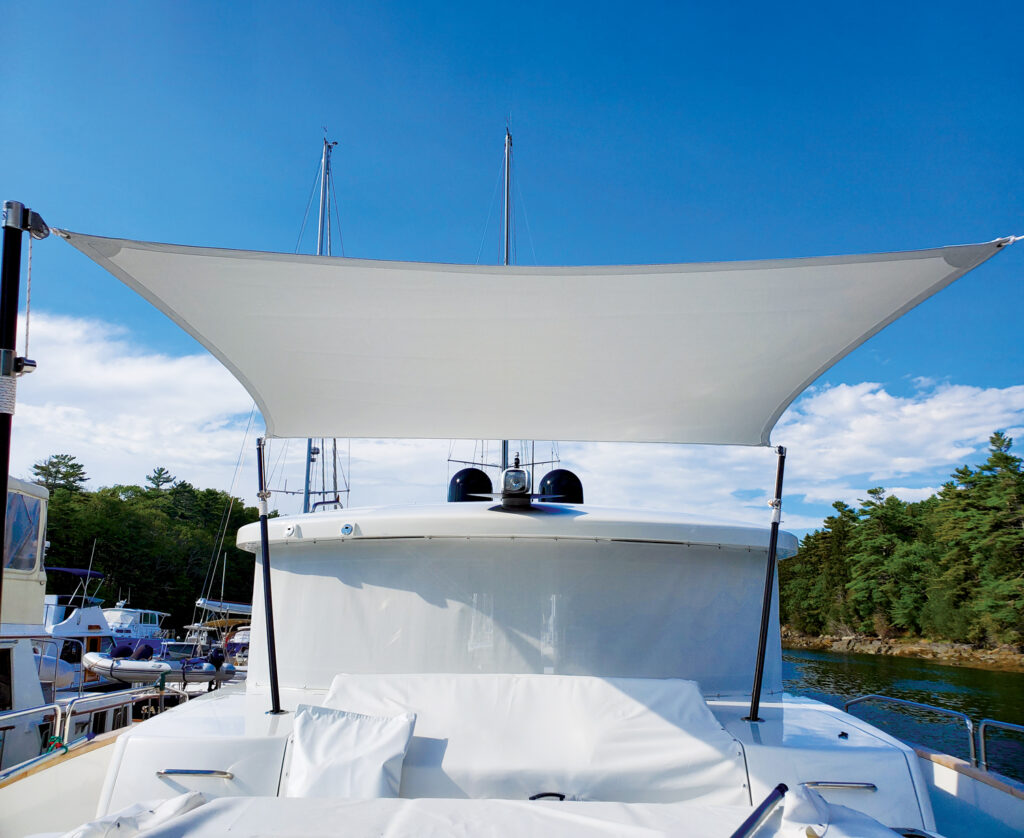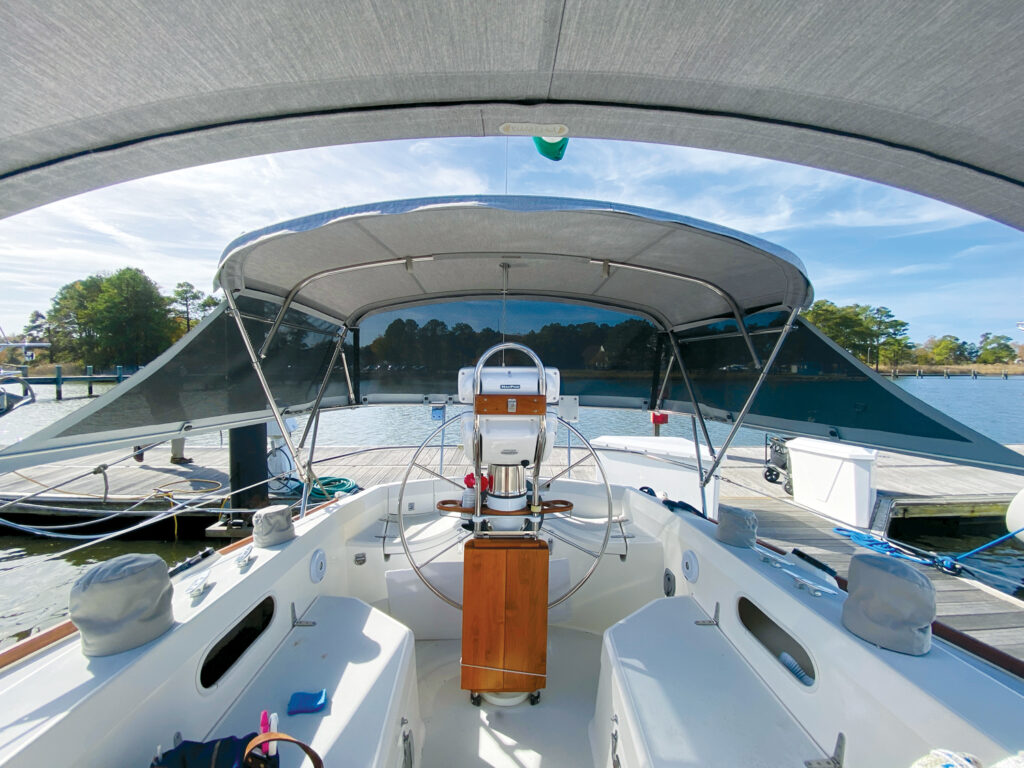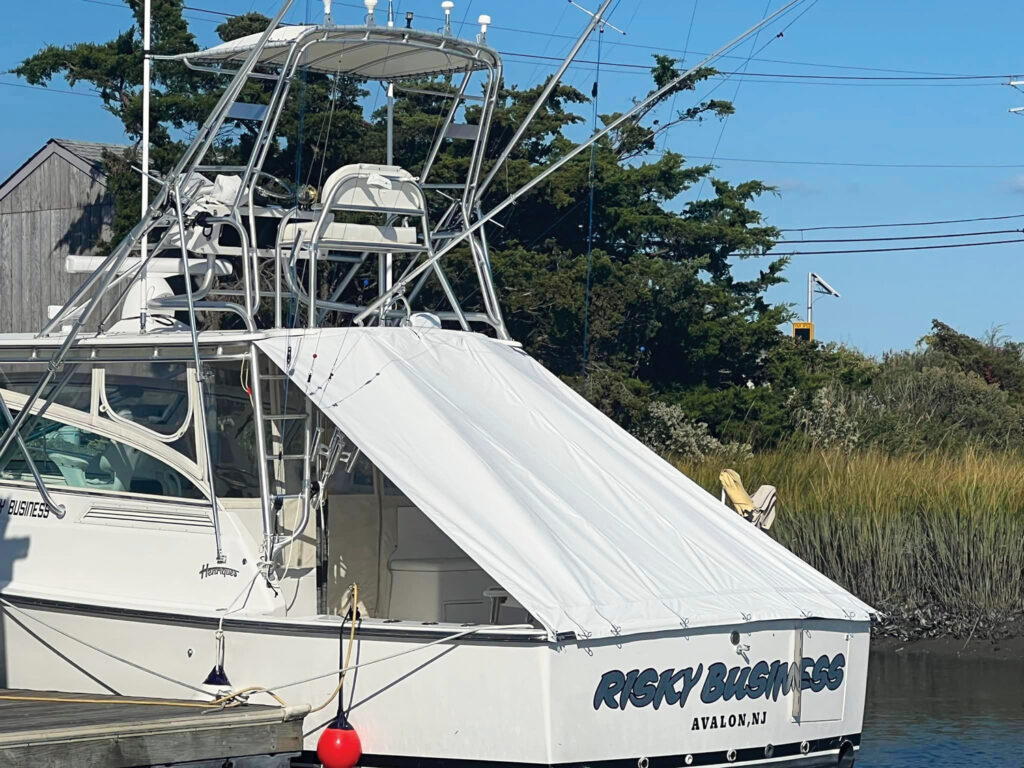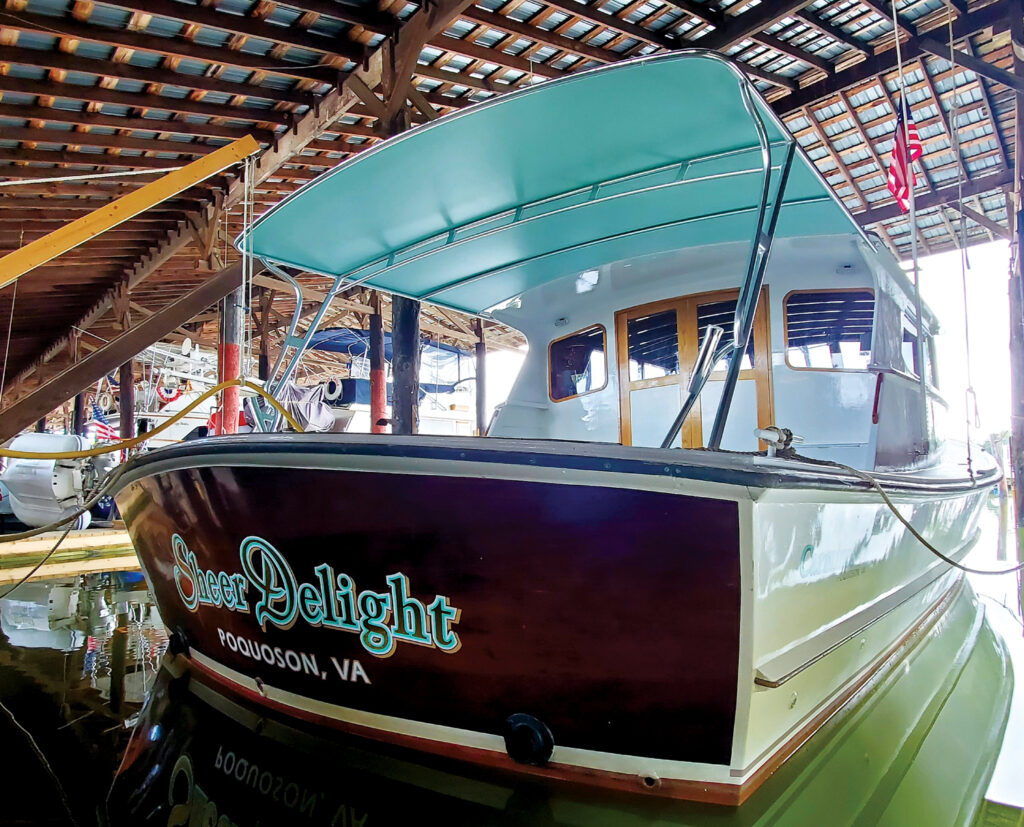
Changing consumer trends, evolving boat designs, and fabric and materials advancements are giving marine fabricators ample opportunity to exercise their creative muscles. Interestingly, the pandemic’s supply shortages also forced some fabricators to juice up their innovation with excellent results. For Tov and Kelsey Renna, co-owners of MarineRennavators LLC, located in Belfast, Maine, supply chain issues provided the inspiration for one of their favorite out-of-the-box moves.
With several sunshade projects awaiting completion, there were no carbon fiber poles available to finish the jobs. Rather than wait an unknown amount of time, the Rennas decided to make the poles themselves.
“Carbon fiber is a cloth; it just uses a different process to turn it into a finished product, not that much different than taking any other fabric and sewing it together, which we do every day,” says Kelsey. “To tension shades, we prefer thick-walled .065 carbon fiber poles. Because the premanufactured poles available in the market use light-walled carbon fiber, they’re too flexible and require additional straps to secure in place—not our modus operandi.”
Tov says they created their version of a heavy-duty tension pole using new 3D printer technology. “We created carbon-fiber-wrapped sleeves to mount hardware like Ronstan polymer roller blocks and Spinlock polymer clutches along with the thick-walled carbon fiber poles,” he says. “That allowed us to fulfill our obligations and complete the jobs on time.”
As an added bonus, devising the carbon fiber sleeve system allowed them to manufacture poles of varying diameters with corresponding sleeve systems suitable for a variety of applications.

Client needs drive ingenuity
According to Keri Ames, owner/fabricator of Yachtsman’s Canvas in North Wales, Pa., clients’ desires for versatility are driving a lot of fabricators’ ingenuity. This, along with the use of innovative fabrics as well as advancements in frame design and hardware, are enabling fabricators to come up with solutions that better align with newer, contemporary boat profiles.
A recent example is a 36-foot sailboat Ames worked on.
“The customer had an existing bimini on a stainless steel frame and wanted additional cockpit shading that was easy to put up, take down and compact to stow,” she says. “The project was designed with one aft shade and two side shades. Each shade is independent of the others to be used together or individually, depending on the client’s needs.”
Ames fabricated the shades out of Marlen Textiles’ new TopGun™ Vision, one of her favorites because of its modern look and feel. She added zippers to the bimini, enabling each shade to be easily and quickly zipped to it using Menax® fasteners at the bottom of the rail to secure the shades.
Tov Renna says they like working with Stamoid Smart, a relatively new, ultralightweight, stain-resistant fabric from Serge Ferrari well-suited for tension shade applications.

Hardware innovations drive change
“The availability of carbon fiber poles has made a huge impact on the tension shade market,” says Tov Renna. “Previously, shade poles were made from 1 1⁄4-inch stainless tubing, which was cumbersome, making them difficult to handle and store. Lightweight carbon fiber poles that don’t rust—another problem with stainless—make installation and storage more manageable.”
Carbon fiber poles have become quite popular compared to stainless steel, says Ames. However, she says they come with both advantages and disadvantages. Their light weight and height adjustability make them less cumbersome for boat owners to handle and stow, and their versatility gives fabricators more design leeway—for example, creating a shade that can move with the sun for greater protection. However, Ames says, their flexibility can pose an issue.
“Typically, a counter strap is required to offset the flex of the pole to maintain a properly fitting shade,” she says. “This adds an additional step to installation for the client.”
For John Hyduck, owner of Hyducks Marine Canvas and Upholstery in Bensalem, Pa., a favorite hardware innovation has been Carbiepoles™ because they allow the covers to be adjusted and moved as needed to protect the boat and the customer. Hyduck, whose company services the New Jersey coast to the Philadelphia area, says two types of shades have proven popular with his customers.
One is a cockpit shade, a permanent solution that goes from the highest point on the area being covered down to the gunwale. He attaches these to the top using Costa Tracks® and keders and 1⁄4-inch stainless steel pins installed into the rub rail. For the covers, he uses MarineTyte® Banyan material, a heavy-duty fabric that can withstand permanent installation.
“These are really only used in convertible-style boats and create a sloped cover to protect the cockpit and any soft goods on the back of the boat,” says Hyduck.
The second type of shade is the sunfly, a temporary solution that can be used on any type of boat. This cover is usually made from Solar-Mesh®—a breathable material that lets in some light while reducing heavy sun exposure, keeping customers cooler—but it can also be constructed from MarineTyte Banyan or Sunbrella®.
“These shades attach to the highest point and are stretched out over the cockpit of the cover, using Carbiepoles to pull the tension over the back of the boat,” Hyduck says. “When we make these covers, we put a roughly 3% arch on the sides of the cover to allow the material to stretch and pull tight, eliminating the sag in the center of the covers.”

Evolving boat styles push trends
Most of Hyduck’s customers use the cockpit covers but have been switching to sunfly shades since these allow people to use more of the boat’s back area. Mike Charlton, owner of Charlton’s Marine Canvas, Yorktown, Va., says that sunflys are also a popular choice for his customers.
“One of the biggest changes in my area is that people are buying more center-console boats,” he explains, saying people are stepping away from cabins because of the space they consume, heightening the demand for temporary shade solutions.
“This style of boat provides a lot of function for the average fisherman. But when they take their families out, the T-tops don’t provide much shade at all,” Charlton says. “Customers also tend not to want something that will permanently compromise the look of the boat. This is where the sunfly comes in handy.”
For his temporary shades, he prefers to use lighter-weight materials like Stamoid Tops and WeatherMAX® 3D because, he says, these tension better when stretching them out with poles. For permanent structures, Charlton also does banded tops. He likes Stamoid Open because it is thicker and strong and “also has a sexy look to it.”
When customers come in looking for shades for their boats, Charlton starts the process by asking how much shade they want and if they’re looking for a permanent or temporary solution. The boat type and style also factor into that decision.
In addition to those questions, Ames asks whether the client is looking for shade while at the dock or anchored, if underway or both. If the shade will have to withstand traveling, speed must be taken into account as does airflow. For removable shades, storage space must also be considered.
Tov and Kelsey Renna factor in headroom and the total area of coverage as well as the client’s primary objectives. Their most popular shade covering is a tension or sunshade, fueled in part by changing boat designs that feature ample amounts of exterior seating.
“Our current version is the amalgamation of traditional awnings, architectural shades, the best attributes of structural tops and a decade of fine-tuning,” says Tov. “The design facilitates an elevated removable canopy with varying forms and sizes tailored to shade the multitudes of exposed seating, lounging and deck areas, creating protective shade for occupants that doesn’t impede the view.”
The Rennas secure the shade by tensioning it to removable poles and the receivers, mounted into the deck. The poles can be used as stand-alones or in conjunction with mounting points on the boat.
“A simple line system attaches the shade to the poles with rollers and cam cleats hand-tensioned for ease of installation and removal,” Tov says. “When not in use, all the major components can be removed and stored, leaving the vessel clean and uncluttered.
“Tension shade concepts aren’t new to the marine industry, with multiple iterations manufactured,” Tov continues. “[Originating] from the sport-fishing community in South Florida, they’ve found a niche in almost every boat market. Some textile manufacturers are now producing new fabrics specifically targeting this market.”
Pamela Mills-Senn is a freelance writer based in Seal Beach, Calif.
SIDEBAR: Creativity unleashed
“One of my recent projects was a sunfly on a 25 [-foot] Parker that incorporated the outrigger poles to support the shade. This project was fun because I had to make the sunfly work not only off the back of the boat but also off the bow with the same outrigger poles. I had to put a lot of outside-the-box thinking on this one to make it work properly. Also, by using the outrigger poles, it eliminates the vertical poles and leaves the boat with no obstructions for moving around.”
-Mike Charlton, Charlton’s Marine Canvas
“Customers had a smaller boat and wanted us to make an enclosure for it, incorporating a sunfly shade that could be removed via zipper and attached to the back of the bimini. They had existing poles and wanted us to make something to fit their needs. It was made out of material that matched their enclosure and came out looking great.”
-John Hyduck, Hyducks Marine Canvas and Upholstery
 TEXTILES.ORG
TEXTILES.ORG


